[If a child does not get nutrition, the damage is permanent. Image by billy cedeno from Pixabay]
There is both a deluge and dearth of information around coronavirus and its impact.
Every day, we get a new bunch of data on how the virus is spreading and every day, we read fresh sets of stories—occasionally uplifting ones, but mostly of pain and suffering, poverty and deprivation. Often, it’s the same story—people not getting food, healthcare, money. Sometimes, it’s a starker version of the old story, for money can run out, buffers can erode and strength can break. Sometimes, they hit us in expected places, for the virus and lockdown play differently on different grounds. And the ground beneath our feet is shifting fast.
The pandemic and the lockdown have also shone light on the amazing work that NGOs are doing to reduce the suffering of fellow humans. But, these organisations are also facing difficulties, because they have to work under severe constraints—less money, less people, less mobility.
Meanwhile, as the pandemic drags on, there is a donor fatigue among people who want to help. Because the ground is shifting, there is no clarity about which cause to support. And there are also stories about fraud and mismanagement in the social sector.
There is a big gap between the intent to donate and making the donation. A big part of it can be plugged with right information. When there is a deluge of data, getting the most useful can be difficult. The signal gets drowned in the noise.
This is one reason why we reached out to a diverse set of leaders in the giving space who know what’s happening on the ground, and requested them to tell us which causes are important, why they are important, and which are the credible organisations that we should support.
Our team at Founding Fuel found the entire exercise eye opening and helpful. We are sure you will find it useful too.
Venkat Krishnan
Founder, India Welfare Trust, #LivingMyPromise Signatory and #DaanUtsav Volunteer
“We are literally letting the poor people of this country suffer and die. It’s almost like we have abandoned them.”
Which causes need special support?
In terms of what is important, there are three things that are critical right now. First and foremost is livelihoods. People's livelihoods have been decimated with the lockdown—and the suddenness of it.
Many people are simply not able to make ends meet. After all, there is only so much you can do with government cash transfers of Rs 1,000-2,000, or even with MGNREGA, which will offer Rs 2,000 to Rs 5,000 a month per family. It’s just not enough to make ends meet.
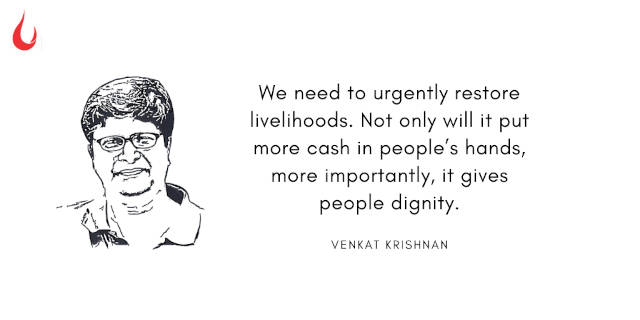
Even in urban areas, people have not got back their jobs. This isn’t about white collar formal jobs, but more about the thousands of street food vendors, Uber and Ola drivers who are part of the gig economy. Many people have stopped paying their maids, drivers and guards after the first four or five months. And in some cases, societies are still not allowing them to come back, despite specific government orders.
Add to that the fact that many of the migrant labour that returned home are starting to come back in droves. That’s evidenced from the fact that trains from places like Darbhanga to the big cities like Mumbai, Bangalore or Chennai are now packed to the brim. These people are realising that there is nothing for them to do in their villages. It is a boon that rainfall has been good. But in Assam and Bihar, there’s also been massive flooding. Entire villages are inundated, impacting agri crops. So that’s forcing many of them to come back and restart livelihoods. And for those that can’t, there is an urgent need to design rural livelihoods.
A couple of days ago, I read a story about the homeless in The Times of India in Mumbai. It was a gut-wrenching story of a single mother feeding her two young children sugar and water because she didn’t have money to buy milk. Now, add to this the fact that most street dwellers like this woman aren’t able to access public toilets. They don’t have money to pay the Rs 20 that these places charge for a bath. Now imagine the health and hygiene implications if you don’t have a bath for a month. The chances of infection and illness will mount. And given that our public health system is overloaded with Covid, there is almost no chance of any OPD treatment either. We are literally letting the poor people of this country suffer and die. It's almost like we have abandoned them.
If a child does not get nutrition, the damage is permanent. We aren’t realising that in trying to save the 100,000 to 200,000 lives from Covid, we are letting millions of kids slide into permanent damage. And that’s why feeding children—and in fact, all human beings—is the second important thing.
The community kitchens that were started in the initial months have gradually wound down. We now need a distributed set of kitchens to cater to the homeless who are scattered across the city. Many of them will not be in any physical condition to trudge 10 km for a meal.
Finally, my third cause is around education for the poor. What if we decide to give all the kids in this country a one year break? Nobody loses anything, life doesn't come to an end. But now, you have one set of well-to-do kids continuing to get access to devices to learn all that stuff. And just another massive set of kids who are getting nothing because they don’t own a device, don’t have internet access at home, etc. And you're merely widening the inequality gap.
While state governments like Chhatisgarh have announced online learning programmes, where are the devices? There is a serious issue of access. In most poor families, there may be at best a smartphone and that is used by the father for his own livelihood. Kids’ education is among the lowest priorities in most such families.
Across the 4.5 lakh students in municipal schools across Mumbai, estimates suggest that only 1.5 lakh have access to a device. What about the rest? In urban areas, the cost of a child’s education for a year in a government school is about Rs 20-30,000 per year, whereas a good device costs Rs 4,000. Do we really have a serious issue in spending an additional Rs 4,000 for a device that would provide access to kids who are missing out?
Why is it important to support?
We need to urgently restore livelihoods. Not only will it put more cash in people’s hands, more importantly, it gives people dignity. After all, a person getting a cash transfer doesn't have the dignity compared to a person who earns that money.
In case migrant labour decide to stay on and not return immediately because of health and safety concerns, rural livelihoods will also need to be addressed on a war footing.
There’s another important dimension: exhaustion is setting in, in terms of giving. That’s palpable. In most disasters, there are two months of immediate relief before life gets back to normal. In this case, there is no end in sight. For instance, I exhausted my own giving programme for the entire year in the three months of April, May and June. And then I sat back and said, like everybody else, I’ve done my bit. What can I now do? Once I read that TOI story I spoke about, I changed my mind. I’ve decided to break my corpus and give away next year’s money this year. There is no point in keeping the money in the bank when people are dying today.
In the past, I have been a proponent of strategic giving. Focus has been a key theme in my giving strategy. But I’ve come to realise that these are extraordinary times. And these causes are interconnected. I might believe my giving for livelihoods will generate the greatest impact. But will it count for much if people are dying of starvation? So it is hard to delineate the causes I support.
How to support the cause?
The big challenge is that most NGOs have focused on livelihoods in a rural context. Whatever work gets done on urban livelihoods happens below the radar. And these organisations aren’t well-known. Therefore, there is an issue of trust.
Samhita-Collective Good Foundation (Samhita-CGF) has started a programme called REVIVE, an alliance of companies, foundations and social organisations to restore livelihoods that were impacted by Covid-19. Co-funded by Michael & Susan Dell Foundation, Omidyar Network India and the Ford Foundation, it will provide accessible and affordable capital in the form of grants and returnable grants/loans to self-employed, disadvantaged segments of workers, and at-risk nano and micro enterprises to either sustain their work or find alternative opportunities. The facility is expected to reach between 60,000 and 100,000 workers/enterprises and will give preference to youth and women. It will also undertake upskilling activities for laid-off youth and informal labourers. For more details, click here. You can also reach out to bhagvath.c@samhita.org.
In Ahmedabad, Naresh Sijapati, founder, Panah Foundation, is working with a clutch of street vendors to help them restart their business for the past two months. He offers small working capital interest free loans of Rs 10,000 to local street vendors, who are expected to repay the loan every month over a 10 month period. The plan is to gradually expand the network by transparently connecting the borrower to the lender.
There is, of course, a more direct way: All you have to do is walk to your local hardware store. (Of course, make sure you strictly maintain social distancing.) Ask the store owner for a list of electricians, carpenters, masons, plumbers, AC repair technicians who are still around and whom you could reach out to. In some localities, there is no one around because they may have gone back to their villages. If they are around, talk to them and find out what’s proving to be their biggest challenge.
For instance, if you’re a marketing pro, you could help design interesting communication, like a poster for WhatsApp which talks about, among other things, how the worker practices safe social distancing. Share it with at least 50 people in your own apartment complex and it will automatically go viral in the neighbourhood.
Another way is to create a working capital pool and provide small loans of Rs 5,000-Rs 10,000 to these people to set up a vegetable cart or a street shop to sell samosas. Offer it as a loan. Ask them to pay it back. But in your mind, write it off as a donation. If they pay it back, that’s great. Pay it forward to the next person.
To help design rural livelihood programmes, social organisations like Goonj may need to come to the fore. To create privately funded works to restore infrastructure, fields, crops and thereby help people earn through that process. And we need to strengthen the thousands of rural livelihood organisations like BAIF, TRIF, Pradan, etc.
(This is an edited version of a conversation Venkat Krishnan had with Founding Fuel)
Anurag Behar
CEO, Azim Premji Foundation
“Speed is of the essence…avoid discovering new organisations during this phase...stick to the ones who you gave to before and significantly increase the size of your contribution”
Which causes need special support?
The first thing to recognise is that the pandemic has basically exacerbated all existing inequities and disadvantages. It’s not as though there are many new kinds or categories of disadvantages or marginalisation that have appeared. Take for example, small and marginal farmers who due to the lockdown from March to May, couldn’t generate the working capital to fund their seeds, fertilisers and tools for the kharif crop. The cascading impact for these families is not just the loss of access to food for the months of lockdown but also the much needed funds for the next year’s crop season. Many of them have now fallen into significant debt and are deeper in the vicious cycle of poverty.
The farmers are just one of the examples to give us a sense of how people’s livelihoods have been annihilated, especially from the informal sector. It’s true of almost everyone right from sex workers to waiters at restaurants. Similar or perhaps worse fate has befallen those who primarily rely on societal support structures to survive—such as a shelter for homeless children. Because of Covid-19, more needs to be done to keep the shelter running safely, such as regular sanitisation. So the needs and costs of running them have increased.
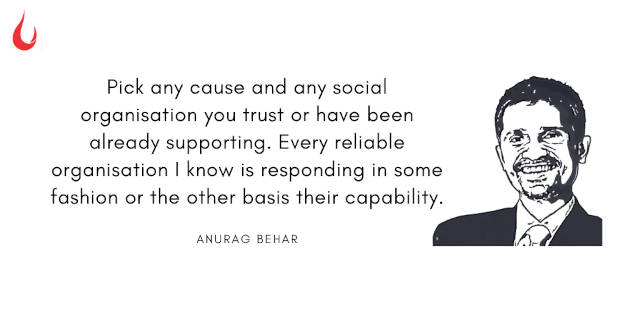
Why is it important to support?
At the same time, the funds such a shelter typically received have dried up, making it a double whammy. I am referring more to the reduction of CSR funds or big philanthropic support, not only individual giving. While we still don’t know exactly why there is such a sharp reduction (and how much) of such institutional funds, the general conjecture is that it’s because of the state of the economy. Many of these institutions may be anticipating a decline in their incomes and have perhaps adjusted their giving budgets or they are not able to operate because of the pandemic. At the same time, a lion’s share of CSR funds seem to have been given to PM Cares. In addition, the foreign funds India received, was already on the decline before the pandemic due to introduction of stringent Foreign Contribution (regulation) Act (FCRA) rules. These funds are also not available so easily anymore given the global pressure on philanthropic resources because of Covid-19.
So, many NGOs and social organisations have had to scale down their staff and programmes, limiting the support the disadvantaged and marginalised have in what is perhaps the most challenging period of their lives. They have been worst hit because of the pandemic on all accounts. They are also at the highest risk of the pandemic itself, with poor access to any kind of healthcare.
Anyone who isn’t from the salaried class or does not have a strong cushion, is largely left to fend for themselves. This means that if you leave aside perhaps 20% of India, 30% are in significant trouble and the (economic) bottom 50% are in deep trouble—and it is not as though their condition was alright before the pandemic. The pandemic is not going to end soon. The current situation would continue for the next 18-24 months, especially for this 80%, who are also likely to be at the margin of any vaccine distribution—perhaps not in principle and planning but in the reality of implementation.
How to support the cause?
While challenges like these will require massive systemic effort from the government, large aid organisations and other stakeholders; for individual donors, you can simply help by increasing the amount of giving during this period.
Pick any cause and any social organisation you trust or have been already supporting. Every reliable organisation I know is responding in some fashion or the other basis their capability. And they require our support. Speed is of the essence. So, I would recommend that you avoid discovering new organisations during this phase. You should stick to the ones who you gave to before and significantly increase the size of your contribution. If you are a first time donor, you can consider giving to Oxfam, Cry, Rainbow Homes, or any other well known organisation.
In case you are unsure about the cause, I would nudge you to consider health—since we do need all hands on the deck to tackle the pandemic; especially the kind that involves community-driven support. When local people own the initiatives to tackle the pandemic, the success and impact is much higher. Local volunteers can play a key role in educating members in communities and building the much required trust—so that when faced with symptoms, people unhesitatingly seek medical support as opposed to fearing the wrath of the system or the fear of the pathetic healthcare facilities. This, of course, requires that healthcare facilities also be made good—which also requires support.
As a parting suggestion, I would encourage you to be open-minded and allow for flexibility when you give. The situation on-ground is rapidly evolving, everything is intimately connected and therefore you should trust the local organisation and allow them to adapt their programmes and support. Take for instance, one of the 700 organisations the Azim Premji Foundation has funded during the pandemic. They were working in the slums of DJ Halli in Bangalore which unfortunately witnessed flooding in the past week. While our initial grant to them was for Covid-related work, if we stuck very narrowly to our original charter, and did not let the organisation evolve the programme to address the flooding and other realities, the Covid work would fail too.
(This is an edited version of a conversation Anurag Behar had with Founding Fuel)
Nachiket Mor
Health economist (With Ankita Shirodariya, Samhita)
“Given the urgency of the situation at hand, our focus must move towards ensuring clinical readiness of the existing primary healthcare centres”
Which causes need special support?
It came as no surprise, in the wake of the Covid-19 crisis that the country’s limited healthcare infrastructure came under severe pressure. Apart from the infrastructure, hospitals started facing acute shortage of trained personnel. In 2019-20, India had a doctor to population ratio of 1:1,456 versus the WHO recommended ratio of 1:1,000. This ratio gets worse when one considers the fact that 80% of doctors and 60% hospitals are in urban areas. Since the Covid-19 cases are rising in the remotest parts of the country (75% of the daily active cases are beyond the top 11 districts as of September 15), the virus will be much more difficult to curb in smaller towns/rural India.
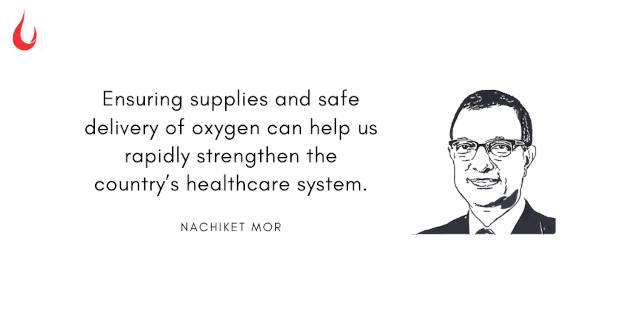
Given the urgency of the situation at hand, our focus must move towards ensuring clinical readiness of the existing primary healthcare centres to triage symptoms and identify the appropriate course of action. An analysis of 72,314 cases by the Chinese Centre for Disease Control (CDC) shows that the severity profile of Covid-19 patients would consist of three broad categories. Eighty percent of the patients could recover at home with mild to moderate illness; of the balance 20%, only 5% may need intensive hospital care or mechanical ventilation and the remaining 15% could be treated for breathlessness and hypoxia using oxygen therapy in primary care settings.
Why is it important to support?
Oxygen therapy can play a central role in alleviating the condition of the patient at a critical time. Experts suggest that nocturnal oxygen therapy in the early stages may be helpful in preventing disease progression by inhibiting the rapid replication of the virus and improving the body’s antiviral ability. It can be delivered at a relatively low cost and by existing personnel after undergoing basic training.
Beyond Covid-19 treatment, oxygenation equipment can also be used to treat multiple respiratory, lung and cardiac diseases. It can also be useful in treating cases of severe malaria, and aid safe delivery of children in cases of labour complications such as Postpartum Hemorrhage—both of which are prevalent in rural areas. Overall, ensuring supplies and safe delivery of oxygen can help us rapidly strengthen the country’s healthcare system.
How to support the cause?
The India Protectors’ Alliance supports the frontline healthcare workers and is working towards making primary healthcare accessible and available to the underserved populations. The Alliance will benefit immensely from your support.
You can donate here.
Luis Miranda
Founder, IDFC Private Equity and Indian School of Public Policy; chair, CORO and Centre for Civil Society.
“Unless government’s intervention is in line with localised needs, the effectiveness will be limited…Six causes emerged as front and centre—food security, livelihoods, health, education, violence against women, and governance.”
Which causes need special support?
With large-scale disruption of life as we know it, the government is struggling to get a grasp on the pulse of the ground. Gaps have emerged in the message chain across different functions of the government—right from grassroots to the district collector to the minister’s office. And hence, there isn’t enough clarity on what people want and where should the government focus its resources and attention next.
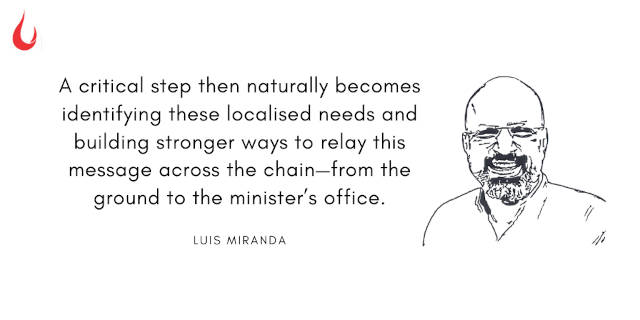
Why is it important to support?
The response to a crisis like Covid-19 can’t be managed centrally from the chief minister’s office alone. Each district and community has been impacted depending on their own context, the shape of their local economy, the prevalence of the disease and several other factors. Some have a migrant labour crisis, some are facing food shortages, others are grappling with violence against women. These are just a few examples that illustrate the growing list of diverse on-ground challenges caused by Covid-19. Unless the government’s intervention is in line with those localised needs, the effectiveness and the efficiency of the impact will be limited.
A critical step then naturally becomes identifying these localised needs and building stronger ways to relay this message across the chain—from the ground to the minister’s office. This will influence the response and ensure the best use of government’s resources.
How to support the cause?
One of the organisations I chair, CORO, has been deeply involved in grassroots leadership work for the past 30 years. The team—based on our experience and feedback from the various communities we work in and where we did extensive Covid-relief work in different areas—came up with a very interesting model.
When the pandemic hit, in addition to the relief work, we launched a unique people-led grassroots initiative called #LokPudhakar. As part of this initiative, we went directly to the people and asked them to list down their collective demands via a simple letter to the sarpanch. Between April and July, we were able to reach 29 districts covering 68 blocks and wards and 542 villages across eight regions of Maharashtra and, similarly, seven districts, 17 blocks and wards and 70 villages across three regions of Rajasthan. Our network of over 1,300 grassroots leaders and our partnership with over 280 partner organisations was critical in facilitating this effort on ground. What emerged were a total of 292 letters.
The charter of demands, from these 292 villages, followed the conventional process—the letters went from the sarpanch, to the block development officer, to the district collectors. This helped in getting the information out quickly and built a better understanding of the needs on ground.
In total six causes emerged as front and centre—food security, livelihoods, health, education, violence against women, and governance. Many of these issues can be resolved through local interventions or funds through the 14th Finance Commission. What was striking was the vividness with which the specific challenges were articulated, sometimes even detailing the specific scheme they were struggling to access or a potential solution. This helps in making the task of the decision makers on ground much easier.
For example, people spoke of the need for food security—many still are unable to access the five kilos of rice and wheat the government has promised; or health—aspects such as funds at gram panchayats to help quarantine people and provide access to Covid-19 testing; or livelihoods—how people who had lost their daily wage jobs needed help in accessing the employee guarantee through MGNREGA or skill training to access new opportunities; or need for public awareness and police patrolling to curb violence against women.
There were some demands from our communities which I personally didn’t agree with. But that’s the important bit—we need to prioritise serving the needs of the community instead of pursuing our own agendas of development.
The process has additionally culminated into meetings with Maharashtra’s education minister (Varsha Gaikwad) and the women and child health minister (Yashomati Thakur) in August. Both now have a more vivid understanding of the needs of the people and have promised more comprehensive action to resolve the issues. We have already seen some success. For example, 2,378 labourers received livelihood income in one district through this process.
While the work to close the loop continues to be in progress, I think the opportunity such dialogues create, in itself, is very powerful. Not only do they strengthen the quality of our response, they also create better feedback loops for effective governance. Therefore, in the coming months, we are also exploring the possibility of institutionalising this through a Critical Response Unit—so that whenever there is a similar crisis, systems exist to inform and influence the government’s localised response. We have completed the basic assessment in 15 villages in Maharashtra and analysis is under progress, thanks to the financial support of Omidyar Network.
Your support will be critical in this journey. Such initiatives can be quickly scaled across India. I urge you to reach out to the dedicated team at CORO to know more and contribute to this bottom-up empowerment initiative. You can find further details here.
(This is an edited version of a conversation Luis Miranda had with Founding Fuel).
Shloka Nath
Head, Sustainability & Special Projects, Tata Trusts; and Executive Director, India Climate Collaborative
“Climate migration, spurred by extreme weather events or a slow degradation of natural resources...leaves migrants without the balm of an eventual homecoming.”
Which causes need special support?
The coronavirus pandemic has ruptured our social fabric along global and local fault lines that were largely invisible to us before this year. One of the key revelations of our country’s vulnerability manifested as the migrant crisis that took place during the early months of lockdown. The magnitude of suffering was a weight on our collective conscience as a nation, as these migrants tread dusty footsteps across the length of the subcontinent on their journey home.
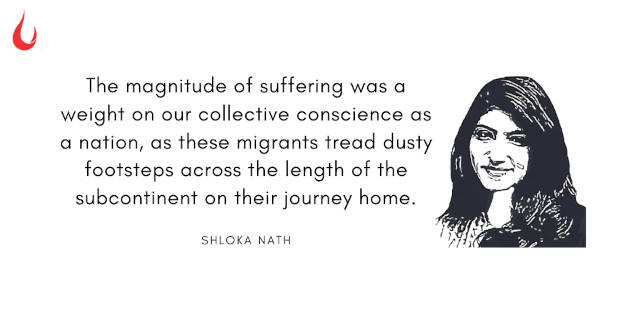
Climate migration, on the other hand, spurred by extreme weather events or a slow degradation of natural resources such as soil, land and water, leaves migrants without the balm of an eventual homecoming. This year alone, a quarter of Bangladesh was underwater due to flooding, and flooding in Assam displaced tens of thousands of people. India has the highest level of disaster displacement in South Asia, and consistently one of the highest in the world. Climate-induced migration often bears a disproportionate weight on those who have contributed the least to climate change, and are also least equipped with the resources to adjust.
Why is it important to support?
As rural communities begin to shift to urban areas seeking new livelihoods in the face of climate disruptions, they become all the more vulnerable—estranged from their families, without social safety nets and often living in makeshift housing (which, in a vicious cycle, is more prone to damage by storms and floods).
How to support the cause?
To this end, Aajeevika Bureau conducts extensive research on migration patterns and works closely with migrant workers and their families to provide healthcare, legal aid, social security and financial services. On the other hand, Mahila Housing SEWA Trust (MHT) empowers women in poor communities to improve their habitats and build resilience to climate-induced risks.
You can contribute to Aajeevika Bureau here, and to MHT here.

